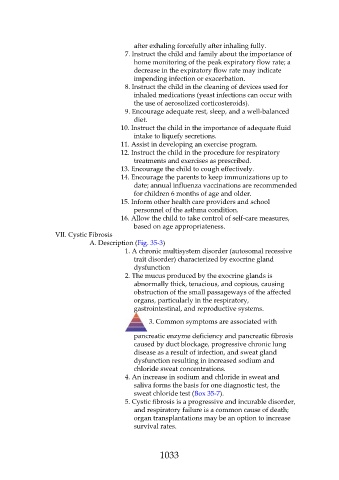Page 1033 - Saunders Comprehensive Review For NCLEX-RN
P. 1033
after exhaling forcefully after inhaling fully.
7. Instruct the child and family about the importance of
home monitoring of the peak expiratory flow rate; a
decrease in the expiratory flow rate may indicate
impending infection or exacerbation.
8. Instruct the child in the cleaning of devices used for
inhaled medications (yeast infections can occur with
the use of aerosolized corticosteroids).
9. Encourage adequate rest, sleep, and a well-balanced
diet.
10. Instruct the child in the importance of adequate fluid
intake to liquefy secretions.
11. Assist in developing an exercise program.
12. Instruct the child in the procedure for respiratory
treatments and exercises as prescribed.
13. Encourage the child to cough effectively.
14. Encourage the parents to keep immunizations up to
date; annual influenza vaccinations are recommended
for children 6 months of age and older.
15. Inform other health care providers and school
personnel of the asthma condition.
16. Allow the child to take control of self-care measures,
based on age appropriateness.
VII. Cystic Fibrosis
A. Description (Fig. 35-3)
1. A chronic multisystem disorder (autosomal recessive
trait disorder) characterized by exocrine gland
dysfunction
2. The mucus produced by the exocrine glands is
abnormally thick, tenacious, and copious, causing
obstruction of the small passageways of the affected
organs, particularly in the respiratory,
gastrointestinal, and reproductive systems.
3. Common symptoms are associated with
pancreatic enzyme deficiency and pancreatic fibrosis
caused by duct blockage, progressive chronic lung
disease as a result of infection, and sweat gland
dysfunction resulting in increased sodium and
chloride sweat concentrations.
4. An increase in sodium and chloride in sweat and
saliva forms the basis for one diagnostic test, the
sweat chloride test (Box 35-7).
5. Cystic fibrosis is a progressive and incurable disorder,
and respiratory failure is a common cause of death;
organ transplantations may be an option to increase
survival rates.
1033

